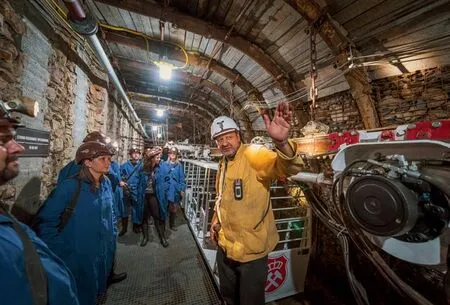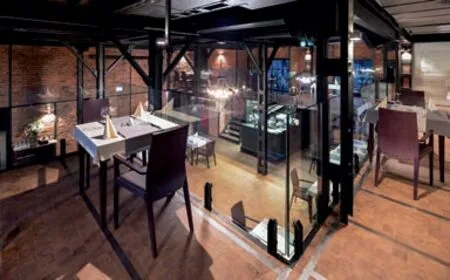西里西亚省的后矿业时代煤矿,波兰
2019-10-17亚当哈伊杜加马雷克戈洛斯帕维尔多斯TextbyAdamHajdugaMarekGoloszPawelDos
亚当·哈伊杜加,马雷克·戈洛斯,帕维尔·多斯 文/Text by Adam Hajduga, Marek Golosz, Pawel Dos
尚晋 译/Translated by SHANG Jin

1 西里西亚省博物馆在原先的“卡托维兹”矿井开设的新馆/The Silesian Museum opened its new seat in the former"Katowice" mine (图片来源/Sources: Ars Cameralis Silesiae Superioris)
密集工业化的时代在西里西亚省已成为历史,但现实中采煤仍在继续。不过,面向新后工业经济,再利用旧工业设施的新途径带来的变化已历历在目。
在西里西亚进行旅游和文化改造的遗址中,不少革新项目是引人瞩目的:卡托维兹的西里西亚博物馆、希维托赫洛维采的波兰矿井卷扬塔、圭多煤矿,以及带有世袭主横井和马切伊竖井的路易斯女王矿井。最后3 处遗址位于扎布热市,那是今天上西里西亚后工业改造的主体,也是省中心。
创立于1929 年的西里西亚省博物馆于2015 年在原先的“卡托维兹”矿井开设了新馆,使6.5hm2的后工业遗址得以复兴。项目为一座主要博物馆提供了场地,将原有的矿业设施改造成博物馆建筑,并创造出引人瞩目的户外空间。奥地利工作室里格勒尔-里韦建筑事务所的建筑理念避免了对这个后工业景观造成过度干扰:巨大的建筑群大部分都隐藏在地下。庞大的地下部分有一个320 座的礼堂、一座图书馆、许多教室和会议室、令人印象深刻的展示空间,以及一座高12.5m 的停车场。这个建筑群包括原华沙竖井的机房和更衣室。前者被改造为一座两层的餐厅,后者是波兰演艺中心大楼。
圭多煤矿建于1855 年,在开采终止后成为排水点和试验矿。如今,这座矿井成了欧洲硬煤矿最深的旅游路线之一:在地下170m、320m 甚至355m 深的地方,游客穿着矿工的全套工作服,重新体会普通矿工的工作。游线以欧洲地下最深的酒馆为终点。这座矿井还举办克日什托夫·彭代雷茨基国际节等艺术和音乐活动。
扎布热的路易斯女王横井是该地区矿业遗产保护的主要项目。路易斯女王矿井是上西里西亚最古老的国有硬煤矿,遗址保留了它原来的地上和地下区域,并加以布置。它包括可运转的蒸汽卷扬机以及由通道和挖掘点组成的迷宫,并在地下展示19世纪以来的采矿机械。最吸引游客的一个景点是通往世袭主横井的1100m 地下水路——欧洲煤矿中最长的水利工程。
扎布热原来的煤矿马切伊竖井实施了注重历史的改造。它是1920 年代以来原康科迪亚煤矿大建筑群的一部分。其中,马切伊竖井建筑群有一座全美食餐厅和时尚酒馆。游人可以参观竖井的主要建筑,以及卷扬塔顶部、机房和水站。2015 年,马切伊竖井作为杰出保护遗迹荣获波兰文化部大奖。
这条工业遗迹路线是波兰集中展示该地区工业文化和遗产各方面内容的主题路线,并在过去10年吸引了650 万游客。□
An era of intensive industrialisation has gone in Silesian Voivodeship, but coal mining keeps beeing involved in its reality. However, there is already possible to perceive the change resulting from the new approach of reuse of former industrial facilities towards new postindustrial economy.
Amongst the sites adapted to tourism and cultural purposes in Silesia, few of them stand out as transformative projects: the Silesian Museum in Katowice, the Polska Mine Hoist Towers in Swietochlowice, the Guido Coal Mine, the Queen Louise Mine with the Main Key Hereditary Adit and the Maciej Shaft. The last three sites are located in the city of Zabrze, the current host of postindustrial readaptations in Upper Silesia, a central part of the voivodeship.
Muzeum Śląskie, founded 1929, opened its new seat in the former "Katowice" mine in 2015 revitalising 6.5hm2of the post-industrial site,by providing a main museum venue, converting former mining facilities into museum buildings and creating an attractive outdoor space. The architectural concept by the Austrian studio Riegler Riewe Architekten avoids over-interference with the post-industrial landscape: most of the large complex is hidden underground. The large underground section comes with an auditorium for 320 visitors,a library, educational and conference halls, an impressive exhibition space, that is 12.5-metre-high carpark. The complex includes the former machine room of Warszawa shaft, converted into a twostory restaurant, and a former clothing storehouse,today's building of Centrum Scenografii Polskiej.
Guido Coal Mine was established in 1855 and served as a drainage point and experimental mine after the end of explotation. Today, the mine offers one of the deepest tourist routes in a hard coal mine in Europe: 170m, 320m and even 355m by depth,where visitors wear full miner's outfit and re-enact common miner's tasks. The tour ends in the deepest located pub in Europe. The mine also hosts artistic and music events such as the Krzysztof Penderecki International Festival.
The Queen Louise Adit complex in Zabrze is the main project of the preservation of the mining heritage in the region. The site preserves and arranges the on-ground and underground area of the former Queen Louise Mine, the oldest stateowned hard coal mine in Upper Silesia. It comprises an active steam winding engine, and a labyrinth of gangways and excavations with an underground exhibition of mining machinery that has been working since 19th century. One of the biggest tourist atractions is an underground water route of 1100m that leads to the Main Key Hereditary Adit - the longest hydro-engineering structure in the European coal mining industry.

2 圭多煤矿/Guido Coal Mine(图片来源/Sources: Coal Mining Museum, Zabrze)
A sensitive transformation is applied in the former coal mine Maciej Shaft in Zabrze. It is part of the bigger complex of edifices of the former Concordia mine from the 1920s. Among others,the Maciej Shaft ensemble offers a full gourmet restaurant and posh pub. Tourists can visit the main building of the shaft, along with the top of hoisting tower, an engine room and a water station. In 2015,the Maciej Shaft won the prize of Polish Minister of Culture as a well-maintained monument.
The Route of Industrial Monuments - the thematical route in Poland that highlights all aspects of industrial culture and heritage in the region -attracted 6.5 million vistors in the last 10 years.□




3-6 圭多煤矿/Guido Coal Mine(图片来源/Sources: Coal Mining Museum, Zabrze)






7-12 路易斯女王横井/Queen Louise Mine(7.9.10图片来源/Sources: Ars Cameralis Silesiae Superioris;8图片来源/Sources: Silesian Voivodeship, Industrial Monument Route;11.12图片来源/Sources: Coal Mining Museum, Zabrze)

13 扎布热马切伊竖井外景/Exterior view of Maciej Shaft in Zabrze(图片来源/Source: Silesian Voivodeship, Industrial Monuments Route)


14.15 扎布热马切伊竖井全美食餐厅内景/Interior views of full gourmet restaurant in Maciej Shaft in Zabrze(14.15图片来源/Sources: Silesian Voivodeship, Industrial Monuments Route)
评论
章明:波兰西里西亚省的后矿业时代煤矿旅游和文化改造项目保留了圭多煤矿全部工艺流程,将新老建筑严格分开,尊重工业遗产的历史价值和文化价值,挖掘地下工业构筑物的空间特征。除此之外,该项目在矿井深处植入现代生活与沉浸式游览模式,凸显了良好的后期策划运营。地面层新建筑所在位置虽然与原先矿坑洞相对应,但其体量以及整个场地的景观划分与原有工厂肌理相脱离,对后工业景观塑造产生了一定干扰。
龙灏:本项目需要处理的是在一个现实中仍在开采的矿区中如何对开采终止后的区域善加利用的问题,和久负盛名的德国埃森鲁尔工业区改造项目相比,设计显然更加注重让游客“深入”体验旧时矿业生产中的点点滴滴:游客不仅可以深入地下逾300m深、体验迷宫般的挖掘点和通道、参观可运转的蒸汽卷扬机,还可以泛舟欧洲煤矿中地下最长的水利工程。这一“深入体验”的过程,伴随着在现代设计的光环境下交替出现的老旧矿业遗迹和当代游憩设施,避免了带给游客过分“幽闭”的感觉。这些,或许正是这一改造项目的成果可以带来启迪的地方。
Comments
ZHANG Ming: The project of mines in post-mining era in Silesian voivodeship, Poland, maintains the historic and cultural value of the industrial heritage through preserving the entire mining system. It separates the old buildings from the new ones and identifies the spectacular characteristics of the underground industrial structures. Besides, this project implants modern life into the mine well and introduces immersive experience for the visitors, which proves to be marvelous scheme and operation. Nevertheless, although occupying the original positions of the mining wells, the scale and the landscape of the new buildings above the ground do not match the former industrial textures, which to some extent disturbs the post-industrial scenery.LONG Hao: The project has to deal with the problem of how to properly use a mining area that is still operating after its eventual termination. In comparison with the renowned German Essen-Ruhr Industrial Area renovation, its design is apparently more focused on visitors' "in-depth" experience of the trivialities in the old mining production: visitors are not only able to descend over 300m underground, immerse themselves among labyrinthine extraction points, and see operable steam winding engines, but enjoy boating in the longest subterranean hydro-engineering work of European coal mines. Such "in-depth experience",with an alternation of old mining monuments and contemporary recreational facilities under modern designs for the lighting landscape, manages to avoid making visitors victims of "claustrophobia". These may well be where the renovation project can bring inspirations. (Translated by SHANG Jin)

16 希维托赫洛维采的矿井卷扬塔/Mine Hoist Towers in Swietochlowice(图片来源/Sources: Silesian Voivodeship,Industrial Monuments Route)
